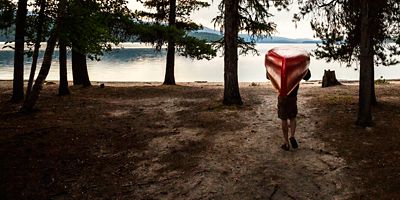Add water to your children’s upbringing and they’ll remember it when they’re well down the river of life on their own. But there are some basics to consider before getting your feet wet to ensure everybody has a great time and wants to go again. Following are a few pointers on everything from paddle-craft to proper safety.
Safety
The number one rule when paddling with kids is to make sure you and your child wear a properly fitted life jacket at all times on the water. Today’s U.S. Coast Guard-approved Type III life jackets are more comfortable than ever, and there’s no excuse not to wear one. Also, stay close to shore until you’re comfortable with self-rescue techniques, and always tell someone where you’re going and when you expect to return. In the event of a capsize, stay calm, make sure everyone is accounted for, and get everyone back in their respective boats (ideally you should always head out in pairs). Wear clothing suitable for the water conditions and weather, bring plenty of drinking water, and slap on the sunscreen (UV rays reflect off the water).
Equipment
There is no shortage of viable family paddle-crafts to pick from. Those living in the mountains often take to waterways and lakes in rafts, canoes and inflatable kayaks. In the Midwest and along the coasts, families break out canoes, sea kayaks and recreational kayaks. Even taking the family rowboat out or inner-tubing a slow-moving creek instills the magic of water. Here’s how to maximize the family-friendly potential of the most popular paddling options to consider.
Inflatable Kayaks
IKs, or duckies as they’re often known, are perfect for family floats on mellow rivers or lakes to introduce your young ’uns to paddling. Made of rubber or PVC, they’re durable—unlike that heirloom canoe—and don’t get dinged by rocks. When it comes to handling, they’re wide enough to be stable, but narrow enough to be maneuverable and fast enough to get you back to shore for snack time. All this creates a versatile craft that gives your kids a more intimate connection with the water than a raft, yet a more stable one than a traditional kayak or canoe. And when you’re through, simply deflate and roll for easy storage back home—which you need, now that your garage is littered with kids’ gear. Consider a tandem for paddling with a younger child in front (depending on the make, you can often convert it easily for solo use once they outgrow it.)
Canoes
They have a major advantage over inflatable kayaks and rafts: You don’t need to inflate them. Simply pop it off your car, throw it in the water, and play Lewis and Clark on your local lake. For younger kids, they even offer playpen-like walls to keep your brood in the boat. These same sidewalls also give them grocery cart-like carrying capacity. Even a simple 16-footer can fit a family of four, as well as Rover. Young kids (aka “bow babies”) can ride shotgun in front of the bow paddler, where they’ll inevitably fall asleep, before graduating to the middle, where they can join in with their own pint-sized paddle.
Once your kids are old enough to start really paddling, put them in the bow. If there’s just one grown-up, turn the boat backwards and place your child up front and you in the rear to give the canoe better trim. When they’re even bigger, turn the canoe back around and paddle it normally, taking turns between bow and stern. But this configuration is also short-lived; by the time most kids are big enough for this, they’ll want a boat of their own.
Sea Kayaks
Unlike canoes, touring or sea kayaks (with dual cockpits) are easily propelled by one person, making them the ideal family option for those with young kids who can sit in the bow while you paddle from the stern. They also keep your lower half out of the wind and rain. Plastic boats are tougher, heavier and less expensive, while fiberglass is lighter and faster, but more fragile and expensive. Until your kids are old enough to paddle solo, put them in tandems while you steer from the stern.
Store gear in front of children’s feet, if needed, so they won’t slide under the deck (or use a dry bag or pad as a booster seat); the added height helps their paddles clear the cockpit rim for forward strokes. And don’t get them a plus-sized paddle; a small one helps teach proper technique by forcing their hands shoulder-width apart (most kids put them too close together), and rotating the torso with each stroke. Also make sure your craft has bulkheads or float bags, and that you have a rescue plan should things go awry.





